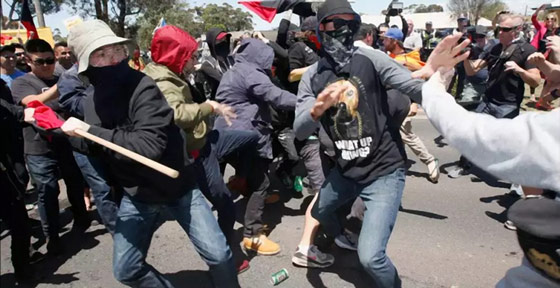How to Survive the Civil Unrest That’s Coming to America
by Daisy Luther, The Organic Prepper:

The rhetoric in the United States is heating up and we’re sounding anything but…well…united. It seems to most media pundits like we are too far down the path to Civil War 2.0 to turn back now. Activists are laying siege to government offices. Threats toward people who disagree are growing in ferocity. It’s ugly and getting uglier. It’s a powder keg that is about to erupt. (Here are some thoughts on what a full-fledged Civil War might look like.)
It is only a matter of time before civil unrest begins to escalate and spread throughout the country. Many people are wondering, how do you keep your family safe during widespread unrest? It’s not about being fearful. It’s about being prepared.
My thoughts on this manipulated division are fodder for another article. (You can find it here.) This article is apolitical (to the best of my ability, anyway) and focuses strictly on what you need to know to survive should the unrest come to your neighborhood.
You need to understand how riots unfold.
First things first, you need to understand how this kind of unrest unfolds so that you can see the warning signs earlier. Never underestimate the power, rage, and motivation of a mob.
Here’s the pattern:
- An outrage occurs.
- Good people react and protest the outrage.
- Those perpetrating the outrage try to quell the protest because they don’t think that the outrage was actually outrageous. (And whether it was or not can fluctuate – in some cases, force is necessitated, but in more and more cases, it is flagrantly gratuitous.)
- Others react to the quelling and join the protest.
- A mob mentality erupts. Thugs say, “Hey, it’s a free for all. I’m gonna get some Doritos and while I’m at it, beat the crap out of some folks for fun.”
- All hell breaks loose.
- The military gets called in.
- The city burns, and neighborhoods get destroyed, and no one in the area is safe.
- Cops act preemptively, out of fear, and for a time, there is no rule of law.
- If you happen to be stuck there, know this: you’re completely on your own.
Tess Pennington wrote about societal breakdowns in more detail – read her excellent article for more information on these predictable scenarios.
Some people are just waiting for the opportunity to behave in this fashion. They’d love to act like that every single day, but they don’t want to spend the rest of their lives in jail. But when a verdict gets rolled out, when a storm takes out the power, when a disaster strikes, they delight in the chance to rob, pillage, loot, and burn. Who can forget the day before Superstorm Sandy hit the East Coast, when thugs were coordinating looting rampages via Twitter?
I remember learning about “sublimation” in a high school psychology class.
Sublimation is a defense mechanism that allows us to act out unacceptable impulses by converting these behaviors into a more acceptable form. For example, a person experiencing extreme anger might take up kickboxing as a means of venting frustration. Freud believed that sublimation was a sign of maturity that allows people to function normally in socially acceptable ways. (source)
If you believe Freud’s theory, then it’s easy to see that many people look for an excuse to revert to their true natures. In a situation where “everyone” is doing something, they are able to cast off the normal control of their impulses without much fear of reprisal. The number of looters and thugs far outstrips the number of arrests going on in Baltimore, so there’s a very good chance that someone swept up in that mentality can go burn somebody else’s home or business and completely get away with it.
Make a flexible plan.
With situations of civil unrest, it isn’t as clear-cut as disasters like a looming storm or a chemical spill. It depends on where you live. In a small town, far away from riots and protests, your lockdown area could be much greater than your own home. It could encompass your immediate community, too, and life might go on as it always has for you, aside from the need to stay just a little closer to home than before.
However, if you live in a city or suburb, it may become essential to make a decision quickly. Do you lock your doors and stay home? Or do you get out of Dodge? It is a question only you can answer. One thing that is very important is this: if you need to go, do NOT miss your window of opportunity to do so safely. If the entire city feels the same way, you’ll most likely be stuck in traffic and trapped in your car. Protesters have shut down the highways more than once in recent years, and you’ll be far safer behind the brick and mortar of your home than you will be in your car.
By the way, there’s always someone who chimes in with a snide remark about how cowardly it is to lockdown with your family in order to stay safe. Blah, blah, blah. If you want to go get involved in a battle to make a political point, that’s certainly your prerogative. However, my priority is the safety of my family, and as such, I hope to avoid engaging altogether.
The first thing you need to do is get home.
If your area is beginning to devolve, the first thing you’re going to want to do is to get everyone in the family home. (Or if your home is in the thick of things, to a safer secondary location.)
In a perfect world, we’d all be home, watching the chaos erupt on TV from the safety of our living rooms. However, reality says that some of us will be at work, at school, or in the car when unrest occurs. You need to develop a “get-home” plan for all of the members of your family, based on the most likely places that they will be.
- Devise an efficient route for picking up the kids from school. Be sure that anyone who might be picking up the children already has permission to do so in the school office.
- Discuss the plan with older kids – there have been rumors that children could be moved by the schools to a secondary location in the event of a crisis. Some families have formulated plans for their older kids to leave the school grounds in such an instance and take a designated route home or to another meeting place.
- Keep a get-home bag in the trunk of your car in case you have to set out on foot.
- Stash some supplies in the bottom of your child’s backpack – water, a snack, any tools that might be useful, and a map. Be sure your children understand the importance of OPSEC.
- Find multiple routes home – map out alternative backroad ways to get home as well as directions if you must go home on foot.
- Find hiding places along the way. If you work or go to school a substantial distance from your home, figure out some places to lay low now, before a crisis situation. Sometimes staying out of sight is the best way to stay safe.
- Avoid groups of people. It seems that the mob mentality strikes when large groups of people get together. Often folks who would never ordinarily riot in the streets get swept up by the mass of people who are doing so.
- Keep in mind that in many civil disorder situations the authorities are to be avoided every bit as diligently as the angry mobs of looters. Who can forget the scenes of innocent people being pepper sprayed by uniformed thugs in body armor just because they happened to be in the wrong place at the wrong time?
- Know when to abandon the plan to get home. Sometimes, you just can’t get there. Going through a war zone is not worth it. Find a different place to shelter. Pay attention to your instincts.
The reality is, family members are likely to be at work or school when things start to break down. You need to have a plan laid out in advance to get everyone together and you need to be flexible enough to know when to go on to Plan B.
Be ready for lockdown.
Once you make your way home or to your bug-out location… STAY THERE.
By staying home, you are minimizing your risk of being caught in the midst of an angry mob or of sitting in stalled traffic while looters run amok. In most scenarios, you will be far safer at home than you will be in any type of shelter or refugee situation. (Obviously, if there is some type of chemical or natural threat in your immediate neighborhood, like a toxic leak, a flood, or a forest fire, the whole situation changes – you must use common sense before hunkering down.)
This is when your preparedness supplies will really pay off. If you are ready for minor medical emergencies and illnesses, a grid down scenario, and a no-comm situation, you will be able to stay safely at home with your family and ride out the crisis in moderate comfort.
Read More @ TheOrganicPrepper.ca



